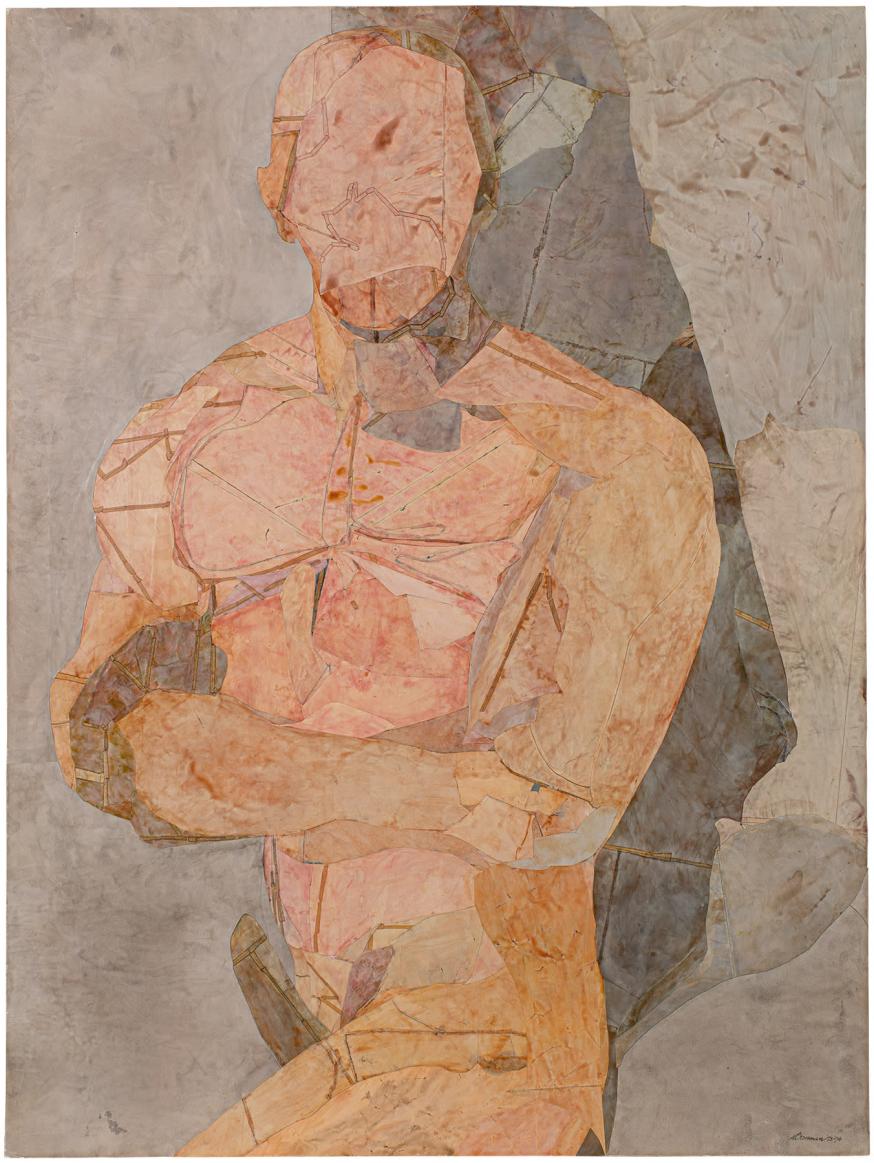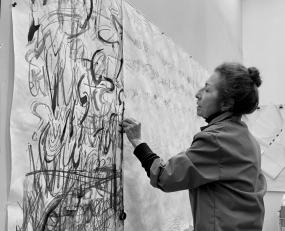Nancy Grossman
b.1940


Nancy Grossman in her Brooklyn, NY studio, February 25, 2021; Photographer Electra Humphries
All artworks displayed above are currently available. To inquire about additional works available by this artist, please contact the gallery.
Biography
The greatest interest in my life has been art. I keep going back to it again and again for my excitement and substance. It Is my way of understanding existence, myself, and other people. It is the only thing I ever really wanted to do. I made the right choice. Art is my fire, my light, my power to transcend the limitations I was handed as a child. It holds the possibility of expressing the heart of the matter and coming closest to the truth. Because we humans, even at our most formal and pompous are so puny and short-lived, we need all we can get recombinant collage of everything we touch as a representation of so fleeting a reality.
A master of sculpture, drawing, and collage, Nancy Grossman (b.1940) was born in New York City to parents who worked in the garment industry. When she was five, the family moved to a farm outside Oneonta, NY, where Grossman grew up among an extended family of eight adults and sixteen children. She demonstrated an advanced drawing ability from a young age, and after her family relocated their garment factory to Oneonta in 1950, Grossman began experimenting with textiles. She finished high school early and enrolled at Pratt Institute in Brooklyn with funding from a New York State Regents Scholarship. Among Grossman’s formative influences was one of her painting instructors at Pratt, Richard Lindner, who became a meaningful friend and mentor until his death in 1978. After earning her Bachelor of Fine Arts degree in 1962, she won an Ida C. Haskell Award for Foreign Travel, which enabled her to spend time in Europe.
In 1964, Grossman had her first solo show Krasner Gallery, which, like many subsequent shows, was well received. The following year she won a John Simon Guggenheim Foundation Fellowship—the only painter to receive the award that year. Grossman’s work of the early- to mid-1960s comprised collages, expressive and colorful figurative works on paper and paintings, and leather and metal assemblage relief works with a related series of line drawings. In 1968 Grossman created the first of her iconic leather head sculptures, which drew widespread attention and acclaim; she would continue to expand the series throughout the following twenty-five years. Initially carved from the wood of discarded telephone poles Grossman applied her superior tailoring skills to create leather sheathes for the sculptures, which and then adorned with zippers, glass eyes, enamel noses, spikes, and straps. While their size, shape, and facial features suggest masculinity, she refers to them as self-portraits, implying the mutability of gender and demonstrating that all artwork offers something of the artist. Exquisite as they are, the heads threaten to overshadow the rest of Grossman’s art, largely due to sensationalistic interpretations that see the sculptures exclusively in a sadomasochistic frame. But these works also contain the central aspects of Grossman’s art: an embrace of gender ambiguity, an interest in formal contradiction and conflict, an audacious use of leather, and a rich sensuality.
By 1970, Grossman had been featured in four more solo exhibitions and was being represented by Cordier & Ekstrom Gallery. Her practice had again expanded and now included abstract collages, freestanding abstract sculptures, and a wealth of abstract and figurative work on paper. In 1970, John Canaday, art critic at The New York Times, praised Grossman’s ability to combine “precise linear representational technique with intense expressive force, a combination that has been rare since the Renaissance,”[1] and the following year declared her “the most impressive young American artist I know of.”[2] In 1973, she created the first works containing her iconic “gun-head” motif—a response to the escalating war in Vietnam—as well as her semi-textual, diaristic collage works. That same year, she initiated her dyed paper collage technique, wherein the exhaustively reworked paper stencils soaked in various pigments to resemble an eerily skin-like surface are arranged to comprise a figural composition. Cordier & Ekstrom Gallery was also the place where Grossman met master collagist Romare Bearden. Both artists were deeply involved in collage at the time and worked together to find a solution they both encountered in their work, namely the warping of their supports from the accumulated weight of layered glue and paper. Through trial and error, they realized that building up weight on the back of the collage would counterbalance the gravitational pull on the front. Their collaboration on this issue became the foundation for a lifelong friendship.
Grossman continued to regularly exhibit new work in gallery exhibitions throughout the 1970s and 1980s, with solo shows at Cordier & Ekstrom, Barbara Gladstone, and Terry Dintenfass Gallery in New York, and Heath Gallery in Atlanta. She expanded her practice further to include editioned bronze sculptures, her iconic series of compositions depicting anonymous figures with guns strapped to their faces, and a group of multi-figure works on paper that situate subjects of both sexes taking theatrical postures in dreamlike tableaux. In the early 1990s, Grossman began a series of collage and assemblage works inspired by the Kilauea Volcano in Hawaii that reinvigorated her landscape practice. In the last twenty years, Grossman has returned to drawing, creating a group of multi-figure compositions that draw on and expound upon themes of past series, with a new emphasis on bodies in motion.
Despite Grossman’s notoriety, audiences generally failed to grasp the astonishing scope of her work until a retrospective curated by Arlene Raven at the Hillwood Art Museum (Greenvale, NY) in 1991, Nancy Grossman, revealed her mastery of diverse media and genres. In recent decades, Grossman’s work has been the subject of two major solo museum exhibitions: Nancy Grossman: Heads at MoMA PS1 which surveyed the artist’s leather head sculptures in 2011, and Nancy Grossman: Tough Life Diary in 2012, a five-decade survey curated by Ian Berry for the Frances Young Tang Teaching Museum and Art Gallery at Skidmore College, which was accompanied by a published comprehensive monograph. In 2007, artist Ugo Rondinone included Grossman in the exhibition The Third Mind, which he curated for Palais de Tokyo, Paris, and selected two of Grossman’s leather head sculptures to illustrate the front and back cover of the special issue of the magazine Palais published in conjunction with the exhibition.
Grossman has been consistently included in numerous important group exhibitions throughout her career; notable shows from the last decade include America is Hard to See at the Whitney Museum of American Art in New York (2015); Delirious: Art at the Limits of Reason, 1950-1980 (2017) and Like Life: Sculpture, Color, and the Body (1300–Now) (2018), both held at The Metropolitan Museum of Art in New York; Art After Stonewall, 1969 to 1989, a traveling exhibition organized by the Columbus Museum of Art, Columbus, OH (2019); NOT I: Throwing Voices (1500 BCE – 2020 CE) at the Los Angeles County Museum of Art (2021); Surrealism in American Art at the Centre de la Vielle Charité in Marseille, France (2021); Useless Bodies? curated by Elmgreen & Dragset, Fondazione Prada, Milan, Italy (2022); New York: 1962-1964 at The Jewish Museum, New York, NY (2022); Over the Rainbow at Centre Pompidou, Paris, France (2023); Ecstatic: Selections from the Hammer Contemporary Collection at the Hammer Museum, University of California, Los Angeles, CA (2023); and A Reverence for Place at Crystal Bridges Museum of American Art in Bentonville, AR (2024).
Grossman has received a steady flow of accolades throughout her long career; in addition to the Regents Scholarship and Guggenheim Fellowship, she has been awarded a National Endowment for the Arts Fellowship (1984), a New York Foundation for the Arts Fellowship (1991), a National Academician Award from the National Academy Museum (1994), a Joan Mitchell Foundation Grant (1996-97), a Pollock-Krasner Foundation Grant (2001), a Women’s Caucus for Art Lifetime Achievement Award (2008), and a National Arts Club Medal of Honor (2024).
Since taking on her representation in 1997, Michael Rosenfeld Gallery has mounted five solo exhibitions of Grossman’s work in addition to including her work in numerous group exhibitions: Nancy Grossman: Loud Whispers, Four Decades of Assemblage, Collage and Sculpture (2000), Nancy Grossman: Drawings (2007), Nancy Grossman: Combustion Scapes (2011), Nancy Grossman: The Edge of Always, Constructions from the 1960s (2014)—which was awarded Best Show in a Commercial Space in New York by the International Art Critics Association of America—and Nancy Grossman: My Body (2022).
Nancy Grossman is represented in museum collections worldwide including the Ackland Art Museum at The University of North Carolina, Chapel Hill, NC; Akron Art Museum, Akron, OH; Arkansas Museum of Fine Arts, Little Rock, AR; Art Institute of Chicago, Chicago, IL; The Baltimore Museum of Art, Baltimore, MD; Berkeley Art Museum and Pacific Film Archive, University of California, Berkeley, CA; Bowdoin College Museum of Art, Bowdoin College, Brunswick, ME; Brooklyn Museum, Brooklyn, NY; The Columbus Museum, Columbus, GA; Columbus Museum of Art, Columbus, OH; Crystal Bridges Museum of American Art, Bentonville, AR; Dallas Museum of Art, Dallas, TX; Fogg Museum, Harvard Art Museums, Harvard University, Cambridge, MA; The Frances Young Tang Teaching Museum and Art Gallery, Skidmore College, Saratoga Springs, NY; Hamline University, St. Paul, MN; Hammer Museum at the University of California, Los Angeles, CA, Hirshhorn Museum and Sculpture Garden, Smithsonian Institution, Washington, DC; Hofstra University Museum of Art, Hofstra University, Hempstead, NY; Honolulu Museum of Art, Honolulu, HI; The Israel Museum, Jerusalem, Israel; Jule Collins Smith Museum of Fine Art, Auburn University, Auburn, AL; Krannert Art Museum, University of Illinois at Urbana-Champaign, Champaign, IL; Los Angeles County Museum of Art, Los Angeles, CA; The Menil Collection, Houston, TX; The Metropolitan Museum of Art, New York, NY; Montgomery Museum of Fine Arts, Montgomery, AL; Museum Boijmans Van Beuningen, Rotterdam, The Netherlands; Museum of Fine Arts, Boston, MA; Museum of Fine Arts, Budapest, Hungary; The Museum of Fine Arts, Houston, TX; The Museum of Modern Art, New York, NY; Nasher Sculpture Center, Dallas, TX; and the National Academy of Design, New York, NY; New Orleans Museum of Art, New Orleans, LA; Pennsylvania Academy of the Fine Arts, Philadelphia, PA; Phoenix Art Museum, Phoenix, AZ; Princeton University Art Museum, Princeton University, Princeton, NJ; Saint Louis Art Museum, St. Louis, MO; Santa Barbara Museum of Art, Santa Barbara, CA; Scottish National Gallery of Modern Art, National Galleries of Scotland, Edinburgh, Scotland; Smithsonian American Art Museum, Smithsonian Institution, Washington, DC; Tel Aviv Museum of Art, Tel Aviv, Israel; Tel Aviv University, Tel Aviv, Israel; The University of Arizona Museum of Art, The University of Arizona, Tucson, AZ; Virginia Museum of Fine Arts, Richmond, VA; Weatherspoon Art Museum, The University of North Carolina, Greensboro, NC; Whitney Museum of American Art, New York, NY; and the Wichita Art Museum, Wichita, KS.
Grossman lives and works in Brooklyn, NY.
Michael Rosenfeld Gallery LLC has represented Nancy Grossman since 1997.
[1] Canaday, “Art: Surprise from Nancy Grossman,” The New York Times, May 30, 1970, also quoted in Raven, 32
[2] John Canaday, “The Least Cruel Artist Alive,” The New York Times, November 28, 1971
Gallery Exhibitions
Press
Publications

